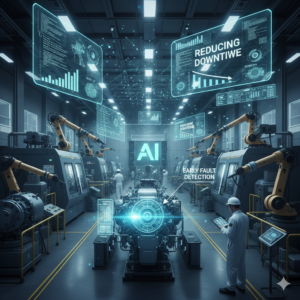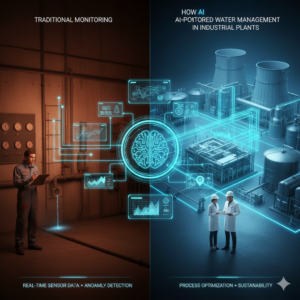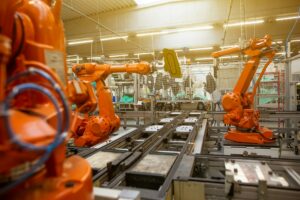Edge artificial intelligence involves bringing intelligence to smart devices without the need for the cloud.

Edge artificial intelligence involves bringing intelligence to smart devices without the need for the cloud.
The vast majority of people are acquainted with cloud-based artificial intelligence in the rapidly developing field of artificial intelligence. If you use voice assistants, artificial intelligence image generators, or smart suggestions on your mobile device, the data will often be sent to powerful distant servers located in the cloud. These servers are responsible for doing all of the processing before sending the results back to your device. A change, however, is taking place in the background, and it is one that is bringing artificial intelligence away from the cloud and into the gadgets that you have in your hand, on your wrist, and in your house. One name for it is Edge AI.
Edge artificial intelligence is a kind of artificial intelligence that operates directly on a device, such as a smartphone, wristwatch, drone, security camera, or smart refrigerator, without the need to continually connect with a cloud server. This transition is not only altering the way in which devices handle data, but it is also opening up tremendous potential for real-time performance, greater privacy, and reduced battery usage.
Let’s go deeply into the inner workings of edge artificial intelligence, the reasons for its current rise, and the implications it has for the future of technology as well as our daily life.
Exactly What Does Edge AI Entail?
In its most fundamental form, Edge AI refers to the process of bringing computation and intelligence closer to the “edge” of a network, which really means closer to the location where the data is being created. Therefore, your device handles the processing of your images, voice commands, or sensor readings locally, as opposed to sending them off to a remote data center for processing.
Imagine what it would be like to have a smart doorbell that can identify a recognizable face without uploading the picture to the cloud. Alternatively, a wristwatch that does not need a connection to the internet in order to monitor your cardiac rhythms and provide you with real-time notifications of any anomalies that may occur. This demonstrates how Edge AI works.
By combining edge computing, which involves processing data close to its origin, with artificial intelligence models that are able to understand data, make judgments, or initiate actions, it is possible to do all of these things on the device itself.
When it comes to 2025, why is edge AI gaining momentum?
Especially in the year 2025, Edge AI has become a developing trend as a result of many significant advancements:
We now have processors that are tiny enough to fit in a wearable device, yet powerful enough to run machine learning models. This is made possible by advancements in chip design, which have led to the development of less expensive and more efficient chips. There are companies that have developed specialized artificial intelligence accelerators and neural engines that make edge AI quick and efficient with energy.
Concerns Regarding Privacy As the knowledge of data privacy continues to rise, an increasing number of users and organizations have expressed a preference for sensitive information, such as faces, voices, or health data, to remain on the device at all times. By storing data locally, edge AI helps to reduce the likelihood of data breaches or abuse.
Reduced Latency Requirements: There are certain applications that just cannot afford the delay that cloud computing causes. Automobiles that drive themselves, drones, and industrial robots all need to be able to make judgments in a split second. Edge artificial intelligence is able to offer findings in real time and does not need a connection to the internet.
Cloud-based artificial intelligence is not effective in locations with limited connectivity or when there are network disruptions. Edge AI guarantees that your smart devices continue to function, even when they are not connected to the internet.
Equipment Used Everyday Already Utilizing Edge AI Although it may seem like something from the future, edge AI is already a component of several products that we use:
- Currently, artificial intelligence is being used on smartphones for a variety of purposes, including face recognition, voice assistants, picture improvement, and even predictive text recommendations.
- Edge AI is used by wearables to monitor sleep patterns, identify arrhythmias, and track exercises without requiring the battery of your phone to be depleted or more data to be sent.
- Smart cameras are used in home security systems to evaluate video feeds in the immediate area to identify people, animals, or suspicious movement. These systems then transmit warnings only when it is absolutely required to do so.
- For the purpose of optimizing logistics, monitoring safety violations, and tracking stock levels, retail and industry are putting sensors and cameras driven by artificial intelligence (AI) at the edge of their operations.
Instances from Real Life That Demonstrate the Effectiveness of Edge AI
Think about a farmer who uses drones to keep an eye on his crops. The procedure would be sluggish and reliant on a reliable internet connection if those drones were required to transfer data to the cloud, analyze it, and then return with insights gained from the process. These drones, however, are able to detect pests, monitor the health of plants, and provide recommendations for remedies on the go thanks to Edge AI.
Consider the possibility of a warehouse where packages are sorted by robots using cameras. Edge AI allows each robot to think for itself, so avoiding bottlenecks and significantly increasing productivity. This is accomplished by preventing video from being uploaded to the cloud.
In the realm of medicine, portable diagnostic devices are able to do instantaneous analysis of pictures such as X-rays or skin lesions. This provides assistance to physicians who work in distant places and do not have access to hospital-grade equipment or the internet.
There are several advantages to using edge artificial intelligence, and one of them is improved privacy. Your personal data will remain on your device. In a time when privacy issues and worries about spying are on the increase, this results in a significant victory.
- Edge artificial intelligence helps to eliminate the “lag” that occurs when data is transported back and forth to the cloud, which results in faster performance.
- Cost Savings: Because there is less of a need for data transport and cloud storage, firms are able to reduce their costs considerably.
- The transmission of terabytes of data to faraway servers consumes more power than the processing of data locally, which results in energy efficiency.
The Obstacles Are Still Present
Undoubtedly, Edge AI is not without its flaws. It is still necessary to use the computational capacity of data centers in order to train huge AI models. Inference, which is the process of utilizing trained models to make predictions or judgments, is one of the strengths of Edge AI.
In addition to this, there is the problem of equipment restrictions. Currently, not all edge devices are capable of doing complicated AI tasks. In order to do this, developers need to carefully build “lightweight” models that strike a balance between speed, accuracy, and power consumption.
One other thing to worry about is safety. Although it is beneficial for privacy to store data on the device itself, doing so also necessitates that the device be fortified against hackers and other forms of manipulation.
Where Does Edge AI Go From Here?
With an eye toward the future, Edge AI is going to be the driving force behind a new generation of smart gadgets that are going to be more autonomous, quicker, and more private than ever before. In industries like as healthcare, automotive, manufacturing, agriculture, and consumer technology, it is quite probable that this technique will establish itself as the standard method.
As a result of Edge AI, you may anticipate smart glasses that translate languages in real time, industrial robots that can effortlessly adapt to new duties without requiring retraining, and products that monitor energy use in order to assist you in lowering your monthly cost.
It is expected that the distinction between cloud intelligence and local intelligence will continue to become more hazy as artificial intelligence models grow more compact and as devices become more powerful. AI will eventually become more than simply something that humans utilize. It is something that will be functioning in the background, all around us, and throughout everything that we possess, and we may not ever recognize it.




